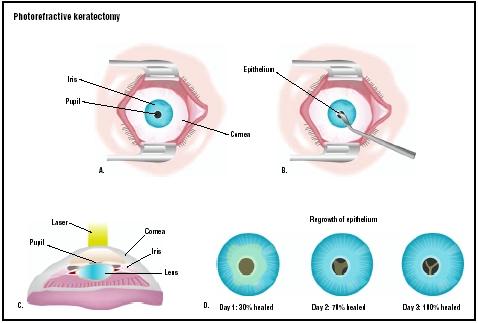Photorefractive keratectomy is a refractive medical operation that does not involve the use of tools in the human body whereby the doctor uses an excimer (a stable atomic pair dimer in which one of the two bound atoms is in a higher energy state) laser to reconstruct the cornea by taking away the epithelium, the jelly-like exterior layer of the cornea.
Purpose
Although PRK decreases nearsightedness (myopia), farsightedness (hyperopia), and astigmatism (blurred vision), this surgery can best take care of myopia. People who have undergone PRK usually do it for many different reasons. A most common reason would be that people do not want to wear spectacles because they want to appear handsome or beautiful. Others who take part in lots of sports or physical training may find spectacles a great hindrance. Moreover, contact lenses often dry up, leaving people with blurred vision.
Process
The whole process is approximately 10 minutes. Directly ahead of the operation, the ophthalmologist will execute a refraction to ensure the refractive alteration the surgeon will instruct the excimer laser is right. Anesthetic drops will be used to numb the eye and disallow pain when the operation starts. After the eye drops are applied, the surgeon places a speculum in the eye to keep the eyelids apart and disallow movement. The patient stares at the twinkling light of a laser microscope and must keep his or her gaze steady on that light, staying motionless at the same time. The surgeon rechecks the laser co-ordinates to ensure they are right for the refractive mistake. When everything is in position, the eye surgeon takes away the epithelium with a sponge, mechanical blade, or the excimer laser. With the epithelium totally taken away, the surgeon will start reconstructing the cornea. Once the process is done, the surgeon puts a bandage contact lens on the treated eye to protect it and allow the healing process to take place; it also eases some of the pain of the exposed cornea. The surgeon will also dispense anti-inflammatory and antibiotic eye drops to stop infection and reduce pain.
Risks
Patients should have a complete eye evaluation and medical history taken before surgery. Soft contact lens wearers should stop wearing their lenses at least one week before the initial exam. Gas-permeable lens wearers should not wear their lenses from three weeks to a month before the exam. Contact lens wear alters the cornea's shape, which should be allowed to return to its natural shape before the exam. Patients should also disclose current medications. Allergy medications and birth control pills have been known to cause haze after surgery. Physicians will want to examine the potential risks involved with these medications. Patients who have these conditions/history should not have the procedure, including:
- pregnant women or women who are breastfeeding
- patients with very small or very large refractive errors
- patients with scarred corneas or macular disease
- people with autoimmune diseases
- diabetics
- glaucoma patients
- patients with persistent blepharitis
Physicians will perform a baseline eye evaluation, including a manifest and cycloplegic refraction, measurement of intraocular pressure (to determine if the patient has glaucoma), slit-lamp biomicroscopy, tear film evaluation, corneal topography, evaluation of corneal thickness, dilated fundus examination, and measurement of scotopic pupil size. If the patient is an appropriate candidate, he or she must sign an informed consent form that states he or she is aware of possible complications and outcomes of the procedure.
PRK patients may experience glare, vision fluctuation, development of irregular astigmatism, vision distortion (even with corrective lenses), glaucoma, loss of best visual acuity, and, though extremely rare, total vision loss. A more common side effect is long-term haze. Some patients who have aggressive healing processes can form corneal scars that can cause haze. With proper screening for this condition and with the use of eye drops, this risk can be lessened. Complications associated with LASIK, such as photophobia, haloes, and dry eye, are not as common with PRK. However, the patient may be under-corrected or overcorrected, and enhancements might be needed to attain the best visual acuity.
Sources:
http://www.surgeryencyclopedia.com/Pa-St/Photorefractive-Keratectomy-PRK.html


Good to see some paraphrasing done. But remember, you cannot plagiarise information. In fact, you should write out this entirely yourself after reading through the online information.
ReplyDeleteDo take note of this in your final reocmmendations.
Ms Chua